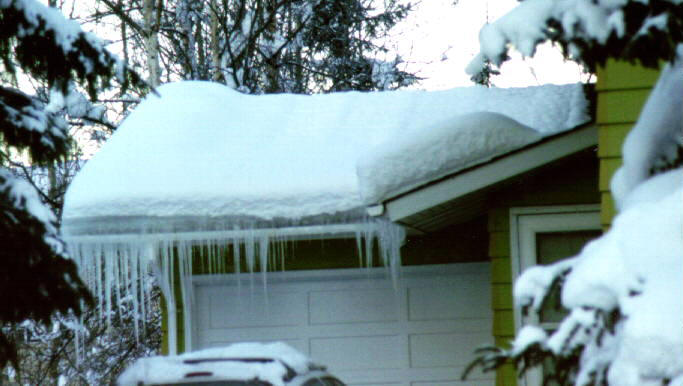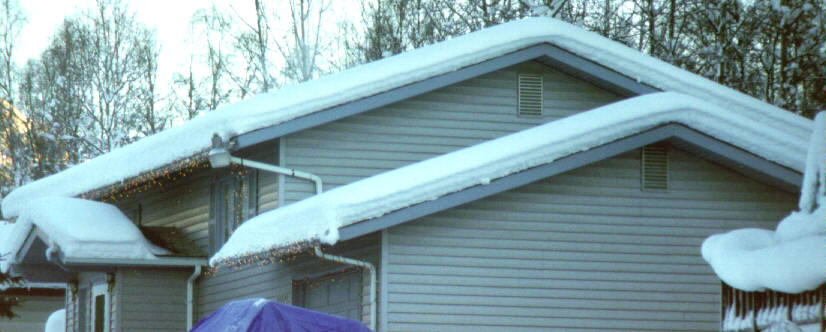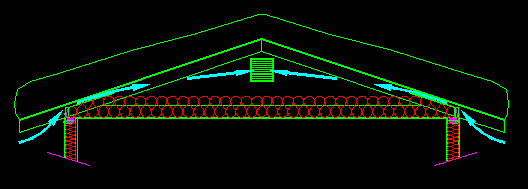| Overview |
| Ground Snow Load |
| Flat Roof Snow Load |
| Sloped Roof Snow Load |
| Partial Loading |
| Unbalanced Snow Load |
| Drifts |
| Sliding Snow |
| Example Problems |
|
References |
| Report Errors or Make Suggestions |
Section 8.3
Flat Roof Snow Load
Last Revised: 11/04/2014
Once you have the ground snow load, pg, you can compute the flat roof snow load, pf.The design snow load represents the peak snow accumulation on a roof over the a winter season. In colder regions the design snow load represents snow deposited by multiple snow events. This may also be true in some more moderate climates as well.
In between snow events, roofs may lose snow mass due to either wind scour or by melting from building heat loss. Roofs have greater wind exposure, usually, than the ground level, and consequently lose more snow. Heat loss from a building with a "warm" roofing system results in losses not seen by the ground level snow. Consequently, the roof design snow load is taken to be less than the ground snow load.
The equation for converting ground snow load, pg, to roof snow load, pf, is ASCE 7-05 equation 7-1. This equation includes factors that take into account exposure and building heat loss. It also includes the importance factor seen in other load types which converts the data to different mean recurrence intervals according the the "importance" of the structure.
Exposure Factor, Ce
The commentary gives great background on the 0.7 factor combined with the exposure factor, Ce. The value of 0.7 is a basic exposure factor and the coefficient Ce further modifies this for various exposures. Values for Ce are obtained from ASCE 7-05 Table 7-2. The given values given a range of exposure from 0.48 to 0.84.
The terrain category is the same as used for the wind loads. The foot notes to ASCE 7-05 Table 7-2 provide the definitions for "fully exposed", "partially exposed", and "sheltered".
Thermal Factor, Ct
Heat loss from a building may result in some snow loss through melting between storm events. Roofs that allow heat loss to melt snow are called "warm" roofs. Other roof systems remove lost heat before it has a chance to melt the snow. These roofs that prevent heat from reaching the snow are known as "cold" roofs. Also, in some cases buildings are either unheated during winter months or are intentionally kept at or below freezing so that there is no heat loss that will result in snow melt.
Figure 8.3.1 shows examples of both a warm roof and a cold roof. These pictures were taken minutes apart so they represent the same snow exposure. Note that, for the warm roof, that there is substantially less snow over the heat portion of the house. In the cold roof example, there has been no loss due to building heat loss. As successive storm deposit more snow, the warm roof will not be seeing the same magnitude of snow load as the cold roof.
Figure 8.3.1
Warm & Cold Roof Examples
 |
 |
| (a) Warm Roof Example | (b) Cold Roof Example |
To be considered a cold roof, there must be sufficient insulation over the heated part of the building AND a mechanism (normally ventilation) for removing any heat from the roof space between the insulation and the snow. A typical cold roof design is shown in Figure 8.3.2. In this design there is sufficient insulation (an "R" value of at least 25 according to ASCE 7-05 Table 7-3) and a means to ventilate the roof space by air entering at the eves and leaving by an end vent that is well above the eaves. The vent area should be at least 1/150th of the ceiling area and should be evenly split between the eaves and the high vent. The elevation difference between the low and high vents should be three feet or more to cause a "stack" effect to move the air through the space. In some cases, mechanical systems have been used to create the necessary airflow.
Figure 8.3.2
Cold Roof Design

ASCE 7-05 defaults to the assumption that roofs are warm. In cases where roof systems or operational parameters prevent snow melt due to building heat loss, the flat roof snow load must be increased over the basic assumption. This is accomplished through the thermal factor Ct.
Values for Ct are found in ASCE 7-05 Table 7-3. If you suspect that your design will act as a cold roof, then the larger Ct value should be used.
Importance Factor, I
The importance factor depends of the building category. The values for this factor can be found in ASCE 7-05 Table 7-4.
Minimum Flat Roof Snow Load Values
ASCE 7-05 Equation 7-1 assumes that the snow load results from multiple events. In regions with relatively low snow load values, the load from a single event may result in the peak loading. As a result, equation 7-1, which accounts for loss between events, will result in a non-conservative value. Consequently, ASCE 7-05 Section 7.3 provides some minimum values for pf on low slope roofs to account for maximum loads from single events.
To restate the requirement in another form:
For low slope roofs (see ASCE 7-05, section 7.3.4):
if pg < 20 psf then
pf = min [ 0.7 Ce Ct , 1 ] * [I pg]
else
pf = min [ 0.7 Ce Ct pg, 20 psf] * I